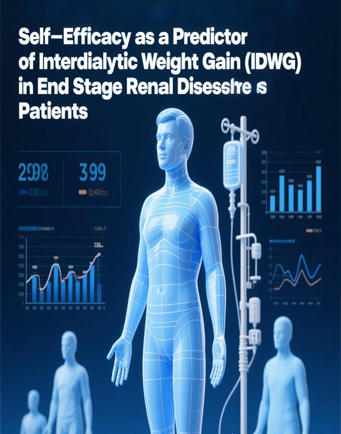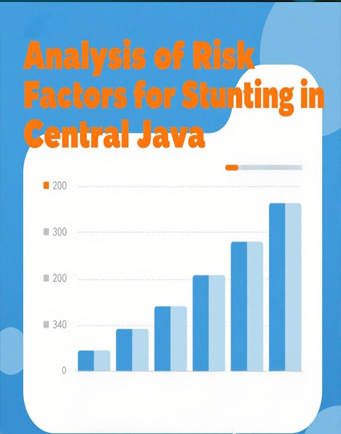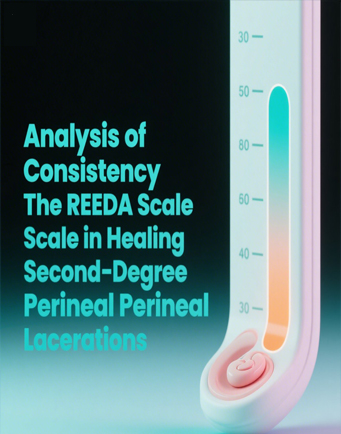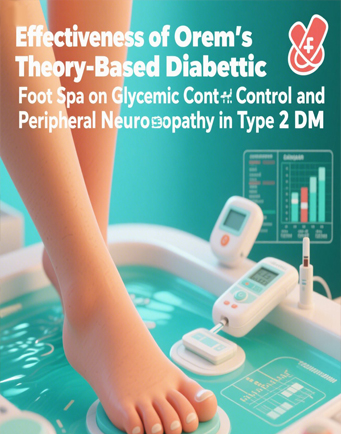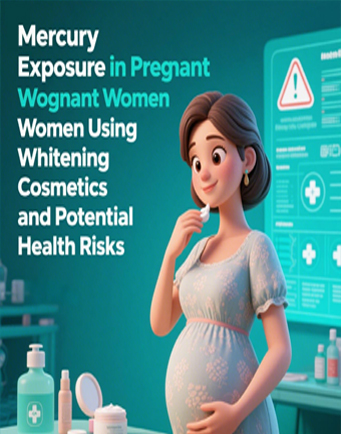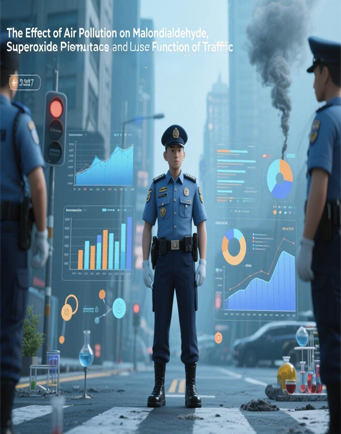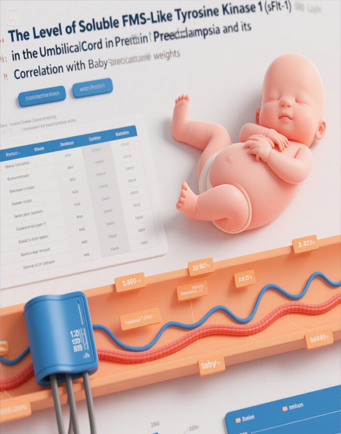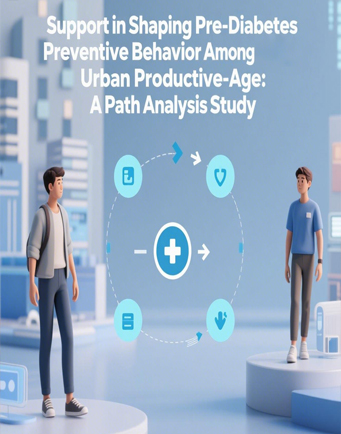The Activity of Older People Determining Their Functional Abilities During Old Age: A Cross-Sectional Study in Two Major Cities In Indonesia
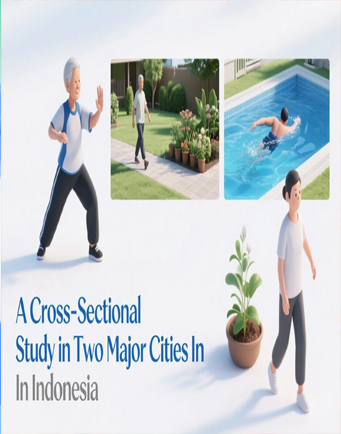
Downloads
Amidst Indonesia's aging population, this study explores key determinants influencing productivity, the indicators of functional abilities, among older adults in diverse urban/rural settings of East Java and Yogyakarta. The study design used a cross-sectional study surveyed 220 adults (≥60 years; mean age 65.3) via stratified probability sampling. Structured questionnaires assessed holistic health (biological, psychological, social, spiritual, cultural), active ageing determinants (social, habitual, physical, personal, economic, service access), and elderly capability improvement (physical, mental, social, spiritual, cultural health). Binary logistic regression identified predictors of productivity status. The study results showed that holistic health conditions (Exp(B) = 0.983, p = 0.050), active ageing determinants (Exp(B) = 1.16, p =0.000), and improvements in elderly capabilities (Exp(B) = 1.090, p = 0.005) were significant positive predictors of productivity. This Indonesian study demonstrates that specific active ageing determinants and enhanced capabilities are more critical to elderly productivity than general holistic health in a multivariate context. It highlights the need for targeted, regionally adaptable community interventions and age-friendly policies to support productive aging.
Åberg, A. C., Sidenvall, B., Hepworth, M., O’Reilly, K., & Lithell, H. (2005). On loss of activity and independence, adaptation improves life satisfaction in old age – a qualitative study of patients’ perceptions. Quality of Life Research, 14(4), 1111–1125. https://doi.org/10.1007/s11136-004-2579-8
Arosio, B., Calvani, R., Ferri, E., Coelho-Junior, H. J., Carandina, A., Campanelli, F., ... & Picca, A. (2023). Sarcopenia and cognitive decline in older adults: targeting the muscle–brain axis. Nutrients, 15(8), 1853. https://doi.org/10.3390/nu15081853
Bowling, A., & Dieppe, P. (2005). What is successful ageing and who should define it?. BMJ, 331(7531), 1548-1551. https://doi.org/10.1136/bmj.331.7531.1548
Butson, M., Jeanes, R., & O’Connor, J. (2025). The effectiveness of aquatic and leisure facility advertising: an older adult perspective. Annals of Leisure Research, 1–18. https://doi.org/10.1080/11745398.2025.2450774
Cesari, M., Sumi, Y., Han, Z. A., Perracini, M., Jang, H., Briggs, A., ... & Banerjee, A. (2022). Implementing care for healthy ageing. BMJ global health, 7(2), e007778. https://doi.org/10.1136/bmjgh-2021-007778
Chaichuay, P. (2024). Factors Related to The Active Aging Concept and Functional Capacity in The Thai Elderly. Journal of Health Science and Medical Research, 43(1), 20241074. https://doi.org/10.31584/jhsmr.20241074
Courtney, M., Edwards, H., Chang, A., Parker, A., Finlayson, K., Bradbury, C., & Nielsen, Z. (2012). Improved functional ability and independence in activities of daily living for older adults at high risk of hospital readmission: A randomized controlled trial. Journal of Evaluation in Clinical Practice, 18(1), 128–134. https://doi.org/10.1111/j.1365-2753.2010.01547.x
El Assar, M., Álvarez-Bustos, A., Sosa, P., Angulo, J., & Rodríguez-Mañas, L. (2022). Effect of physical activity/exercise on oxidative stress and inflammation in muscle and vascular aging. International journal of molecular sciences, 23(15), 8713. https://doi.org/10.3390/ijms23158713
Escourrou, E., Durrieu, F., Chicoulaa, B., Dupouy, J., Oustric, S., Andrieu, S., & Gardette, V. (2020). Cognitive, functional, physical, and nutritional status of the oldest old encountered in primary care: a systematic review. BMC Family Practice, 21(1), 58. https://doi.org/10.1186/s12875-020-01128-7
Fekete, C., Siegrist, J., Post, M. W. M., Tough, H., Brinkhof, M. W. G., & SwiSCI Study Group. (2020). Does engagement in productive activities affect mental health and well-being in older adults with a chronic physical disability? Observational evidence from a Swiss cohort study. Aging & Mental Health, 24(5), 732–739. https://doi.org/10.1080/13607863.2019.1576158
Fernández-García, Á. I., Gómez-Cabello, A., Moradell, A., Navarrete-Villanueva, D., Pérez-Gómez, J., Ara, I., ... & Vicente-Rodríguez, G. (2020). How to improve the functional capacity of frail and pre-frail elderly people? Health, nutritional status and exercise intervention. The EXERNET-Elder 3.0 project. Sustainability, 12(15), 6246. https://doi.org/10.3390/su12156246
Filho, D. S. (2024). Functional Training in Older Age: Benefits for Health and Quality of Life. Health and Society, 4(01), 90-100. https://doi.org/10.51249/hs.v4i01.1829
Frías-Luque, M. D., & Toledano-González, A. (2022). Determinants of quality of life and well-being in cognitively unimpaired older adults: a systematic review. PeerJ, 10, e12900. https://doi.org/10.7717/peerj.12900
Grevendonk, L., Connell, N. J., McCrum, C., Fealy, C. E., Bilet, L., Bruls, Y. M., ... & Hoeks, J. (2021). Impact of aging and exercise on skeletal muscle mitochondrial capacity, energy metabolism, and physical function. Nature communications, 12(1), 4773. https://doi.org/10.1038/s41467-021-24956-2
Holstein, B., Due, P., Almind, G., & Avlund, K. (2007). Eight-year change in functional ability among 70- to 95-year-olds. Scandinavian Journal of Public Health, 35, 243–249. https://doi.org/10.1080/14034940601072372
Izquierdo, M., Merchant, R. A., Morley, J. E., Anker, S. D., Aprahamian, I., Arai, H., ... & Singh, M. F. (2021). International exercise recommendations in older adults (ICFSR): expert consensus guidelines. The journal of nutrition, health & aging, 25(7), 824-853. https://doi.org/10.1007/s12603-021-1665-8
Jeste, D. V. (2022). Non-medical social determinants of health in older adults. International Psychogeriatrics, 34(9), 755–756. https://doi.org/10.1017/S1041610222000709
Kabadayi, S., Hu, K., Lee, Y., Hanks, L., Walsman, M., & Dobrzykowski, D. (2020). Fostering older adult care experiences to maximize well-being outcomes: A conceptual framework. Journal of Service Management, 31(5), 953–977. https://doi.org/10.1108/JOSM-11-2019-0346
Lima, R. V. N., Cardoso, I., Lima, L. E. D. M., Ferreira, J. S., & Alencar, G. P. D. (2021). Effects of strength training on functional capacity and health of the elderly: an integrative review. Research, Society and Development, 10(12), e81101220131. https://doi.org/10.33448/rsd-v10i12.20131
Lu, S. (2025). Functional ability and its associated factors among Chinese people aged 50 years and above from the perspective of healthy aging: A 7-year longitudinal study. Journal of Aging & Social Policy, 37(2), 289-304. https://doi.org/10.1080/08959420.2023.2226286
Martínez-Hernández, B. M., Rosas-Carrasco, O., López-Teros, M., González-Rocha, A., Muñoz-Aguirre, P., Palazuelos-González, R., ... & Denova-Gutiérrez, E. (2022). Association between physical activity and physical and functional performance in non-institutionalized Mexican older adults: a cohort study. BMC geriatrics, 22(1), 388. https://doi.org/10.1186/s12877-022-03083-7
Marzo, R. R., Khanal, P., Shrestha, S., Mohan, D., Myint, P. K., & Su, T. T. (2023). Determinants of active aging and quality of life among older adults: systematic review. Frontiers in public health, 11, 1193789. https://doi.org/10.3389/fpubh.2023.1193789
Maseda, A., Diego-Diez, C., Lorenzo-López, L., López-López, R., Regueiro-Folgueira, L., & Millán-Calenti, J. C. (2018). Quality of life, functional impairment and social factors as determinants of nutritional status in older adults: The VERISAÚDE study. Clinical Nutrition, 37(3), 993–999. https://doi.org/10.1016/j.clnu.2017.04.009
Mendonca, G. V., Pezarat-Correia, P., Vaz, J. R., Silva, L., & Heffernan, K. S. (2017). Impact of Aging on Endurance and Neuromuscular Physical Performance: The Role of Vascular Senescence. Sports Medicine, 47(4), 583–598. https://doi.org/10.1007/s40279-016-0596-8
Merchant, R. A., Morley, J. E., & Izquierdo, M. (2021). Exercise, Aging and Frailty: Guidelines for Increasing Function. The Journal of Nutrition, Health and Aging, 25(4), 405–409. https://doi.org/10.1007/s12603-021-1590-x
Merchant, R., Chan, Y., Anbarasan, D., & Woo, J. (2024). The Impact of Exercise and Cognitive Stimulation Therapy on Intrinsic Capacity Composite Score in Pre-Frail Older Adults: A Pre-Post Intervention Study. The Journal of Frailty & Aging, 13(2), 131–138. https://doi.org/10.14283/jfa.2024.16
Moreno-Agostino, D., Daskalopoulou, C., Wu, Y. T., Koukounari, A., Haro, J. M., Tyrovolas, S., ... & Prina, A. M. (2020). The impact of physical activity on healthy ageing trajectories: evidence from eight cohort studies. International Journal of Behavioral Nutrition and Physical Activity, 17(1), 92. https://doi.org/10.1186/s12966-020-00995-8
Naah, F. L., Njong, A. M., & Kimengsi, J. N. (2020). Determinants of active and healthy ageing in Sub-Saharan Africa: Evidence from Cameroon. International journal of environmental research and public health, 17(9), 3038. https://doi.org/10.3390/ijerph17093038
Nascimento, C., Ribeiro, A., Cotta, R., Acurcio, F., Peixoto, S., Priore, S., & Franceschini, S. (2012). Factors associated with functional ability in Brazilian elderly. Archives of Gerontology and Geriatrics, 54(2), e89-94. https://doi.org/10.1016/j.archger.2011.08.005
Nurhayati, U. A., Laksono, T., & Hasnawati, B. N. (2024). Correlation of Fitness Levels with Physical Activity in Elderly Patients in Yogyakarta, Indonesia. Jurnal Keterapian Fisik, 9(1), 47–58. https://doi.org/10.37341/jkf.v9i1.434
Palestin, B., Kholifah, S. N., & Arna, Y. D. (2022). The Determinants of Active Aging for Improving Elderly Abilities. Asian Journal of Pharmaceutical Research and Development, 10(6), 14-17. https://doi.org/10.22270/ajprd.v10i6.1203
Pan, Q., Hu, J., Yangzong, Zhang, X., & Zhaxidawa. (2024). Factors associated with elderly health-Related quality of life in Tibet: A Cross-Sectional study from a health ecological perspective. Journal of Multidisciplinary Healthcare, 17, 177-190. https://doi.org/10.2147/JMDH.S436486
Park, J., & Lee, K. (2024). The Relationship Between Active Aging Index And Physical Function Of Community-Dwelling Older Adults. Innovation in Aging, 8, 917–917. https://doi.org/10.1093/geroni/igae098.2960
Paterson, D. H., & Warburton, D. E. (2010). Physical activity and functional limitations in older adults: A systematic review related to Canada’s Physical Activity Guidelines. International Journal of Behavioral Nutrition and Physical Activity, 7(1), 38. https://doi.org/10.1186/1479-5868-7-38
Plouffe, L., & Kalache, A. (2010). Towards global age-friendly cities: Determining urban features that promote active aging. Journal of Urban Health: Bulletin of the New York Academy of Medicine, 87(5), 733–739. https://doi.org/10.1007/s11524-010-9466-0
Purwantini, D., & Lestarina, N. N. W. (2024). Kebugaran Fungsional pada Lanjut Usia Laki-laki dan Perempuan. Indonesian Journal of Kinanthropology (IJOK), 4(1), 8-14. Retrieved from: https://journal.unesa.ac.id/index.php/IJOK/article/view/28701
Rantanen, T., Saajanaho, M., Karavirta, L., Siltanen, S., Rantakokko, M., Viljanen, A., ... & Portegijs, E. (2018). Active aging–resilience and external support as modifiers of the disablement outcome: AGNES cohort study protocol. BMC public health, 18(1), 565. https://doi.org/10.1186/s12889-018-5487-5
Skelton, D., & Dinan, S. (2007). Explaining about… the benefits of active ageing. Working with older people, 11(4), 10-14. https://doi.org/10.1108/13663666200700063
Slaug, B., Granbom, M., Björk, J., Rantanen, T., Schmidt, S., & Iwarsson, S. (2024). Attaching More Meaning To The Home Supports Active Aging Despite Functional Decline. Innovation in Aging, 8, 90–91. https://doi.org/10.1093/geroni/igae098.0282
Suso-Palau, D., López-Cuadrado, T., Duque-León, D., Ortiz, C., & Galán, I. (2022). Predictive capacity of self-rated health on all-cause mortality in Spain: Differences across sex, age and educational level. J Epidemiol Community Health, 76(10), 888–894. https://doi.org/10.1136/jech-2021-217965
Tek, N. A., & KaraÃ, M. Å. (2018). Determinants of health related quality of life in home dwelling elderly population: appetite and nutritional status. The Journal of nutrition, health and aging, 22(8), 996-1002. https://doi.org/10.1007/s12603-018-1066-9
Tomás, M. T., Galán-Mercant, A., Carnero, E. A., & Fernandes, B. (2018). Functional capacity and levels of physical activity in aging: a 3-year follow-up. Frontiers in medicine, 4, 244. https://doi.org/10.3389/fmed.2017.00244
Wang, L.-Y., Chen, H.-X., Zhu, H., Hu, Z.-Y., Zhou, C.-F., & Hu, X.-Y. (2024). Physical activity as a predictor of activities of daily living in older adults: A longitudinal study in China. Frontiers in Public Health, 12, 1444119. https://doi.org/10.3389/fpubh.2024.1444119
Welch, V., Mathew, C. M., Babelmorad, P., Li, Y., Ghogomu, E. T., Borg, J., ... & Howe, T. E. (2021). Health, social care and technological interventions to improve functional ability of older adults living at home: an evidence and gap map. Campbell systematic reviews, 17(3), e1175. https://doi.org/10.1002/cl2.1175
Zhang, W., & Wang, A. P. (2025). Functional ability of older adults based on the World Health Organization framework of healthy ageing: a scoping review. Journal of Public Health, 33, 1513-1531. https://doi.org/10.1007/s10389-023-02121-x
Copyright (c) 2025 JURNAL INFO KESEHATAN

This work is licensed under a Creative Commons Attribution-NonCommercial-ShareAlike 4.0 International License.
Copyright notice
Ownership of copyright
The copyright in this website and the material on this website (including without limitation the text, computer code, artwork, photographs, images, music, audio material, video material and audio-visual material on this website) is owned by JURNAL INFO KESEHATAN and its licensors.
Copyright license
JURNAL INFO KESEHATAN grants to you a worldwide non-exclusive royalty-free revocable license to:
- view this website and the material on this website on a computer or mobile device via a web browser;
- copy and store this website and the material on this website in your web browser cache memory; and
- print pages from this website for your use.
- All articles published by JURNAL INFO KESEHATAN are licensed under the Creative Commons Attribution 4.0 International License. This permits anyone to copy, redistribute, remix, transmit and adapt the work provided the original work and source is appropriately cited.
JURNAL INFO KESEHATAN does not grant you any other rights in relation to this website or the material on this website. In other words, all other rights are reserved.
For the avoidance of doubt, you must not adapt, edit, change, transform, publish, republish, distribute, redistribute, broadcast, rebroadcast or show or play in public this website or the material on this website (in any form or media) without appropriately and conspicuously citing the original work and source or JURNAL INFO KESEHATAN prior written permission.
Permissions
You may request permission to use the copyright materials on this website by writing to jurnalinfokesehatan@gmail.com.
Enforcement of copyright
JURNAL INFO KESEHATAN takes the protection of its copyright very seriously.
If JURNAL INFO KESEHATAN discovers that you have used its copyright materials in contravention of the license above, JURNAL INFO KESEHATAN may bring legal proceedings against you seeking monetary damages and an injunction to stop you using those materials. You could also be ordered to pay legal costs.
If you become aware of any use of JURNAL INFO KESEHATAN copyright materials that contravenes or may contravene the license above, please report this by email to jurnalinfokesehatan@gmail.com
Infringing material
If you become aware of any material on the website that you believe infringes your or any other person's copyright, please report this by email to jurnalinfokesehatan@gmail.com.



